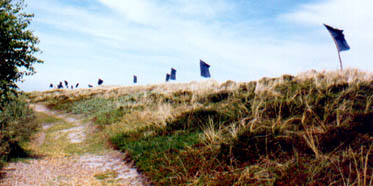BAFA © 2010. All material here is copyrighted. See conditions above. |
Reviewed by Sonja van Kerkhoff
The Netherlands.
|
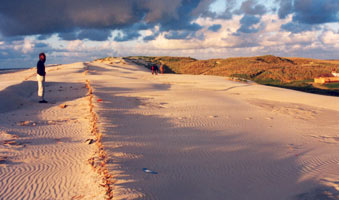
Terschelling Island, 1996.
Photo: S. van Kerkhoff.
|
An island is a stage
Review of Oerol, international arts festival 1996
Terschelling island,
The Netherlands.
The Oerol festival is well known in the Netherlands as an international festival of surprises, where all of the small northern island of Terschelling is the stage. For two weeks last June, there were several hundred theatre, music, dance, mime and
|
and street performances in old off-the-beaten-track sheds, on the beach, in fields, on a lake, in an 'igloo', behind a dyke, on the streets, along the roads and of course, in pubs
and clubs.
Plons, an arts foundation consisting of four artists, co-ordinated a visual art presence for the first time, as part of the 1995 Oerol festival. They chose the theme Heilige Huisjes (Holy Houses) and 70 artists created house forms in a great variety of materials and exhibited them all around the island.
This year (the 14th Oerol festival), the theme was the Magnetism of the north pole. This theme is particularly signficant because an artic expedition led by William Barentz left Terschelling in the 1800's, which resulted in the boat being land-locked by the ice. The men built a house out of the wood of the boat, wintered in it, and then in the summer rebuilt the boat from the same wood, and sailed back. |

Paul Edens (on ground), a member of Plons, working on his work, Het Magnetisme v/d Ontoegankelijkheid (The Magnetism of Inaccessibility) for the Oerol festival.
|
What struck me when I first arrived was the confrontation with nature and the way the festival reinforced this.
Your entrance pass was a map and a compass. Like it or not, you had to learn how to read a compass in order to find the locations, and you needed a bicycle if you didn't want to walk for hours.
| 
Terschelling Island, 1996.
Photo: S. van Kerkhoff.
|
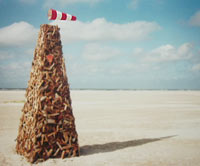
Toren II, '96, by Corine Nijenhuis, part of the visual arts route.
|
I think the island must have the highest density of bicycle hire shops in the Netherlands! And it was great.
On a bicycle, you were vulnerable to the winds, the rain and the sun. Cycling, passing villages and farms, the exertion, and the constant taste of the sea, were part of the arriving.
This emphasis on the expedition process was a strength of the festival, because everyone was forced to undergo this process one way or another.
|
Joop Mulder's (the initiator behind Oerol) idea was that people would have to search to discover a location rather than just go to it, so the accent on navigation was more than a gimmack for the north pole theme.
Even those just over for the day, and only, say just there for the crowd-puller, I-Den performance, which began on the beach metres from the ferry terminal, still had to negotiate a five kilometre or more, walk in semi-darkness.
|
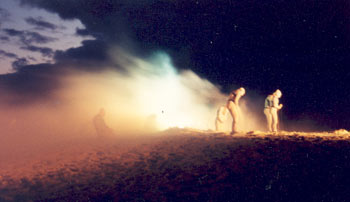
I-Den, Myth of the future choreographed by Shusaku Takeuchi, Japan. Photo: S. van Kerkhoff.
|
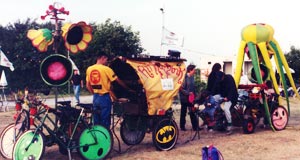
A U.K. group with their cycled-powered 'music-box'.
|
Even, if you remained with the 399 other ticket-holders, you stil had to watch your step, as lights flashed, sirens went on and off, and the 'action' changed to different sites in the never-ending expanse of sand and mud flat.
Humour and creativity were a way for local farmers, foresters, street artists, dancers, choreographers, tourists -anyone, to all participate in the same festival. Such as cycling past a |
border of 'icebergs' made out of farming plastic or being stopped by border police, who searched you for penguin eggs. The borders between art and entertainment were well and truly mixed. |
There was a Spanish circus, Derevo, a Russian avant-garde theatre group that carried an enormous egg around and performed enroute along the streets and roads of small villages. Latin American, Yiddish, Jazz, Classical, Caribbean, Punk-Folk, and Underground bands filled the streets.
A UK group produced music from a cycle-powered mobile sound system, and a local bar owner placed a piano on the beach with the only proviso that, when finished, the lid should be closed.
|
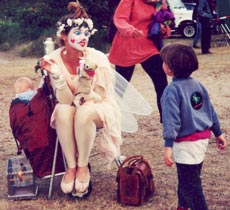
A festival-goer in costume. Photo: S. van Kerkhoff. |
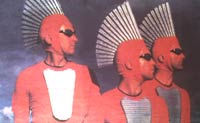
Chrome, an Australian trio.
|
Was the Australian trio, Chrome who performed while travelling by bicycle in costume around the island, a street performance or a comment of staging?
There was something for everyone, from the huge informal crowds to intimate intense experiences. Of the latter, theatre groups were commissioned to create a piece for a farmer's shed, where the state of the shed was to be left was it was.
|
One unforgettable performance here was Baila Beluga performed by the Dutch theatre, H2O en Zn. About 20 of us assembled outside the shed until we were led by a woman in red through a side door, where we had to edge past a very tall woman in white dragging a long rusted saw in one hand.
All was still, while we watched the intense wooden movements of this woman, drag the top of her head against the low ceiling, then push the front of her face around obstacles such as wooden beams. It seemed as if she was being controlled by strings from above. It was both disturbing and gripping to watch someone at the edge of pain and control.
After she reached the end of the last of the animal stalls, a door flew open and we tentatively entered the central space of the shed. Dust and cobwebs covered many of the rusting implements, and the sounds of creaking and wind were accentuated by the recorded sounds of birds, from a walkman suspended from a post. We all looked around to see if we could guess where the 'action' would happen.
|

Baila Beluga performed by the Dutch theatre, H2O en Zn.
Photo: S. van Kerkhoff.
|
Then I heard a rhythmic creaking coming from below and moved to where the others had gathered to look. My five year old son, Toroa, absorbed by the sounds of the floorboards was slowly shifting the weight from foot to foot. I looked up to see a man above waiting with ropes in his hands, and a smile on his face. I saw that this contribution was welcomed. Then, with perfect timing, as Toroa stopped and walked on, oblivious to the audience around him, a plank flew down along a rope to the ground.
While looking around and listening for an indication of what would happen next, I noticed the woman in red standing with her back to us, staring out of the window. She gave a hesitant and barely discernable wave to the distant view. Just as I was sensitized by this moment, -an act not quite ordinary, the sounds of falling metal caused everyone to turn around to see the long woman in white engaged in throwing old metal bits and pieces out of an old grain shaft. To our horror, she climbed into it, manoeuvering her long self into the middle wiht the long rusted saw.
|
Suddenly, our attention was diverted back to the woman in red who rushed forward to knock loudly at each of the stall doors, where she listened for a moment, and then moved on to the next. A man emerged from the last door, wearing a bucket and loudspeaker over his head. Various voices could be heard from the loudspeaker. While he marched mechanically towards the other side of the shed, the woman in red followed, and then cut the cord coming from his head, silencing the voices that came from the loudspeaker.
Now we all turned around, back to the noise of scrapping coming from the grain shaft. The woman in white emerged out the other end of it, still dragging the saw.
|
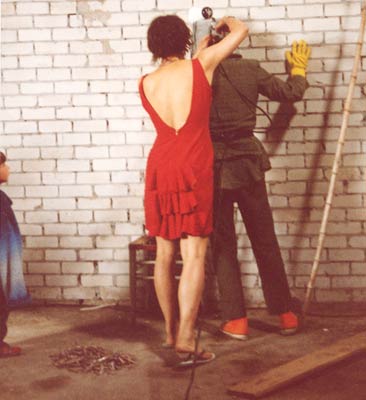 Baila Beluga
Baila Beluga performed by the Dutch theatre, H2O en Zn.Photo: S. van Kerkhoff. |
She walked zombie-like through one of the open stall doors, closing it behind her.
Then we heard the sound of sawing and could see her above the door, cutting a hole in the ceiling in another stall. When she had finished, she walked back into the central space and then through an outer door, that had just flung open, which was also our exit door. Now all the doors flungs in the shed suddenly opened opening up all the spaces to our gaze.
|
A loud irritating buzzing sound drove us out of the shed and, on emerging outside, in the distance, we saw the woman in red seated on a trailer beside a record player playing something romantic. She stood, waved towards the sea, and disappeared into a caravan. We clapped. I asked Toroa which parts, did he find strange and he asked me what was strange about it? So I was left to my own thoughts, on the senses and the social self, as we cycled back towards the village sounds.
|

Baila Beluga performed by the Dutch theatre,
H2O en Zn. Photo: S. van Kerkhoff.
|
The performance, I-Den, Myth of the future, choreographed by Shusaku Takeuchi, designed by Wies Noest, and incorporating the fire performances of the British artist, Paka, also touched on the intense and personal, even though the 'stage' seemed to be endless kilometres of waste land, and you felt as if you chose your own course. Afterwards, I realised that the audience movements were as orchestrated as in the Baila Beluga piece. |
It began at 10 p.m., at dusk.
After a walk of roughly half a kilometre towards the sea, the audience encountered beings dressed in colourful padded multi-layered costumes, with frame-structures around them.
Some individuals stood as if listening to something we could not hear, others moved very slowly in one or other direction, and others stood motionless around a fire.
|
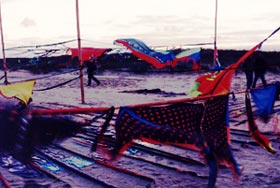
I-Den, Myth of the future, choreographed by Shusaku Takeuchi, Japan. Photo: S. van Kerkhoff.
|

I-Den, Myth of the future, choreographed by Shusaku Takeuchi, Japan. Photo: S. van Kerkhoff.
|
Further on, following the crowd, I encountered sticks and suspended material positioned in and on the sand, much like formal garden.
Then there were flashed of light in the distance, and as I got closer, I saw a huge colourfully lit banner suspended between two sand hills.
|
On the way, I encountered white or grey clad 'actors' standing, staring or engaged in a self-conscious dance-action, such as bending, turning sumersaults, or, in one case, handing out blocks of ices to those who ventured near.
Many costumes were highly inventive. One woman was covered in white paper filters, another dragged a large birdcage-like structure. |
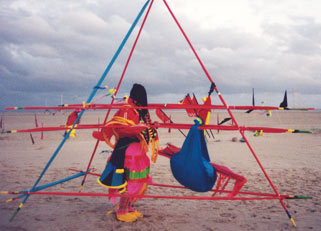
I-Den, Myth of the future, choreographed by Shusaku Takeuchi, Japan. Photo: S. van Kerkhoff.
|
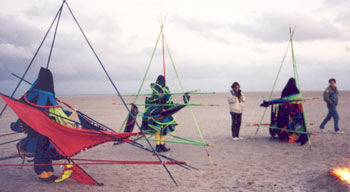
I-Den, Myth of the future, choreographed by Shusaku Takeuchi, Japan. Photo: S. van Kerkhoff.
|
Although the costumes and sometimes the lighting and movements created a sense of estrangement, the actors were always clearly human, since you could walk up to them and look them in the eye, if you dared.
At times, it felt as if the performance consisted of you, the viewer, wandering around and encountering actions, lights and sounds by chance in a charged atmosphere.
|
Yet, by the end, it was clear that the whole show was tightly choreographed, and that the composition was an expedition to be negotiated.
Walking in the direction of distant lights and sounds led us to a circular stage far out on the sand, where 20 dancers performed with small lamps and fire.
|

I-Den, Myth of the future, choreographed by Shusaku Takeuchi, Japan. Photo: S. van Kerkhoff.
|
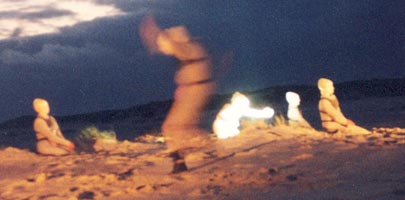
I-Den, Myth of the future, choreographed by Shusaku Takeuchi, Japan. Photo: S. van Kerkhoff.
|
The performance seemed like a battle theatre, where grey-clad beings danced with and against each other, with tight choreographic precision. It ended when those that had fallen were dragged out of the circle and the lights and fires dimmed.
The return journey in the darkness was an opportunity to internalise these events until, in the middle of nowhere, it seemed, we encountered the grey being again. This time on lit-up pedestals or half-buried in the sand.
|
A huge truck an motorbike then headed in our direction - at top speed, flashing lights or spurting fire. Just before I started to worry about whether they could see us or not, the vehicles turned away from us, and headed for another group of strollers.
Yet, by the end, it was clear that the whole show was tightly choreographed, and that the composition was an expedition to be negotiated.
Walking in the direction of distant lights and sounds led us to a circular stage far out on the ssand, where 20 dancers performed with small lamps and fire. The performance seemed like a battle theatre, where grey clad being danced with and against each other, with tight choreographic precision. It ended when those that had fallen were dragged out of the circle and the lights and fires dimmed.
The return journey in the darkness was an opportunity to internalise these events until, in the middle of nowhere, it seemed, we encountered the grey being again. This time on lit-up pedestals or half-buried in the sand. A huge truck an motorbike then headed in our direction - at top speed, flashing lights or spurting fire. Just before I started to worry about whether they could see us or not, the vehicles turned away from us, and headed for another group of strollers.
As we neared the lights of the village -lights of the familiar- I was blinded by them. We all stumbled and struggled in the dark, trying to find our way back to where we began.
| |

I-Den, Myth of the future, choreographed by Shusaku Takeuchi, Japan. Photo: S. van Kerkhoff.
|
Shusaku Takeuchi studied at an art school in Japan, and has been involved in happenings form the '60s onwards, where he became interested in using his body as his art form, later moving into physical theatre work.
|
I-Den, Myth of the future, is his third commission for Oerol, a modern dance piece influenced by butoh. The performers come from dance, acting and mime backgrounds, creating their own movements in line with Takeuchi's concept.
It was a piece about letting go (going around the grand narrative), so that we are left to work on the sensations of the expedition itself. Then my five-year old son, told me that it was a story afterall. First, he said, the dancers were writers, then friends, then they fought, made friends again, and finally took everyone away.
|
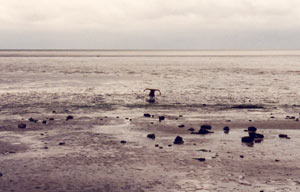
A Pool of Tears, choreography and performance by Ericka Voortman, The Netherlands.
Photo: S. van Kerkhoff.
|
Ericka Voortman's dance performance, A Pool of Tears was a metaphor for a journey of the spirit, where a sort of mermaid-like siren slowly walked from the sea towards the beach. The audience was gathered on a dyke looking down. As she came out of the sea and her movements became gradually more discernable, the low tones of Polish composer, Hendrick Gorecki's music created an eerie and surreal atmosphere.
|
Sterk Water (Strong Water) was performed by the Utrecht based group, Telder in and around an igloo covered with approximately 10,000 plastic bags of water.
The igloo, designed by Pieter van de Pol, who had exhibited it on a smaller scale in the Oerol 1995 Holy Houses exhibition, was impresssive. A hommage to the power (importance) of water.
|
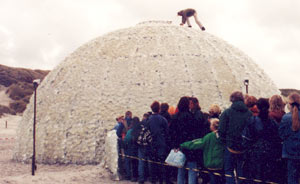
Sterk Water (Strong Water), choreography and performance by the Dutch theatre group, Telder
Photo: S. van Kerkhoff.
|
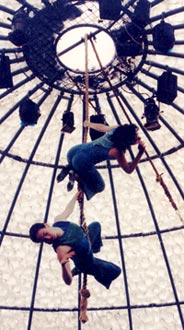
Sterk Water (Strong Water), choreography and performance by the Dutch theatre group, Telder
Photo: S. van Kerkhoff.
|
The piece began while we queued, waiting to enter. Two two dancers were dragged from the sea on a plank towards the igloo. They then climbed onto the top of the igloo while we crouched through the opening. The light was naturally deflected by the bags and inside each audience of 150 was seated on water-filled plastic bags around the circular stage, surrounding our bodies in containered water.

The dancers then descended down the rope from the opening above and danced a mixture of modern and ballet to music on themes of water. |
F.O.G.H.M.C. (Fools Oracle Guided Headmix Collective) were one of the many bands that inspired the huge informal crowds. These are a collective of five diverse musicians, improvising along folk, gypsy, reggae lines. They took turns in leading where one of the musicians, John, said that their aim was for a "no boss collective", while adding that they still have a lot of morphising to do. Nuala and Athene are versatile violin players, while Peni's Breton pipes brought a strong folk element into their music.
|
Another U.K. band Tragic Round About, also drew in the crowds. Their Yiddish Klezmer influenced songs full of witty take-offs, stops and starts, and various changes of key, had everyone dancing. The five-man band have been performing at festivals in the U.K., Spain and Finland, for the last three years. They prefer to perform on the street for informal audiences.
And I mustn't forget the Yakitori restaurant! Comedians from four nationalities kept people in fits of laughter, as members of the restaurant. The gags just didn't stop. | 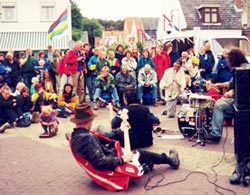
A Tragic Round About street performance.
Photo: S. van Kerkhoff, The Netherlands.
|
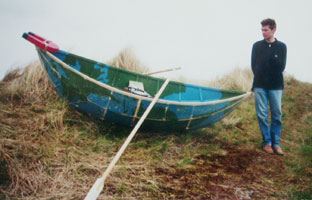
Droomboot (Dreamboat), by Paul Reintjes,
The Netherlands.
|
In contrast, the art installation positioned all over the island were often highly personal encounters. Some works literally referred to magnetism, such as Paul Reintjes' canvas kayak, perched up on a hill. A large magnet pointed up from the bow of the boat, while a record player played songs from various parts of the globe. The canvas surface illustrating the distorted continents of the globe, was a witty comment on how small the world is, or how one's perspective of it is easily influenced.
|
Linda Verkaik's installation, Over water lopen (Walking on water) focussed on the experience of the north pole. She laid a pattern of large fine sheets of metal netting over the surface of a small lake. In between floating clusters of small bobbing penguins.
These were accompanied by an evocative soundscape of cracking ice, whales, seals, and the sound of water which boomed out from speakers on the small islands in the lake.
|
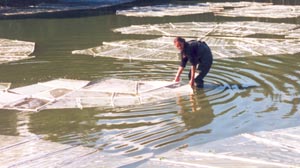
Linda Verkaik at work on her installation, Over water lopen (Walking on water).
|
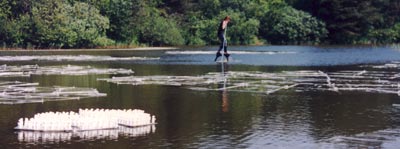
Linda Verkaik's installation, Over water lopen (Walking on water).
|
She was fascinated by the fact that ice allows one to do the impossible: to walk over water.
Fiona de Bell's installation, Het Lichtend Pad (The Lit Path), involved literally following a path over water. Once visitors negotiated the path of floating drums to the ship, then a light show inside the boat was their reward.
The installation, De deuren van Terschelling (the doors of Terschelling), the work of eight second year sculpture students at the Utrecht art school, faced the sea, indicating a metaphorical path. |
The doors came from an old boarding home for sailor's children. One of the artists found it fitting that the doors faced the same sea that had separated those children from their parents. There were ten doors in total, some were only frames in which various objects, such as bottles and mirrors hung. Another doorway had flaps that opened or closed wih the current.
|

Detail of De deuren van Terschelling (the doors of Terschelling). Photo: Hans van der Vliet.
|

image to come of Common Property by the artist group, Grip.
|
Another artist group, Grip (grasp), consisting of three painters and an installation artist, was inspired by the story of the discovery of frozen bodies in coffin-like boxes, which were found in the 1950's on the north pole. It seemed, according to the book, Frozen in Time that these 17th century tourists, realising they were trapped, built boxes for their final place of rest (and provision). According to Astrid, one of the artists, "It seemed that the people ventured out to cross unknown boundaries and yet were trapped by a lack of basic provisions." |
The four made boxes that contained some of the things they felt were basic provisions, such as food, warmth, and a means of finding one's direction. The five boxes scattered in the barren landscape were much mroe than illustrations of these concepts. For example, in a five-sided box, layers of padding surrounded a smaller red box in which a teacpot was centrally placed. First you could laugh at the irony of having a padded pot of tea, or of the isolation of a teapot from social custom, or perhaps admire the aesthetic use of material. Each box had a strong sense of the aesthetic, where many materials were displayed under a layer of ice-like perspex. These 'common property' boxes, like display cabinets, showed glimpses of our common needs and desires.
|
|
The Danish artist, Tina Herslund, arranged the words: "een horizon zo weids dat je niet verder loopt maar terug, en dan is het pad er al weer" (a horizon so immense that you do not walk forward but backwards, and then there is the path, again)
by plaiting them out of dune grass, across dune-covered hills. The text is a 're-shaping' of a sentence from the novel, De mens treedt op in het holoceen by Max Frisch, where the main character is isolated by a natural calamity and his way of being confronted with this, is to study an encyclopedia - a man-made ordering of the natural world.
|

|
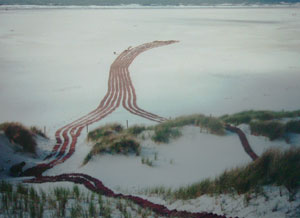
Jacqueline Toben (The Netherlands) made a current out of 7000 roof tiles. Roof tiles function at the boundary of sky and earth, and here the seven lines of vulnerable earthenware create a fossilized current in search of water in the direction of the north pole. Photo: Peter Edens, The Netherlands. 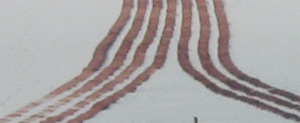 |
She chose this text, to give expression to an ambiguity many contemporary West Europeans have developed towards nature, where they have cultivated and controlled the environment, and at the same time, because of this detachment from nature, romanticised it. She also thought that such a sentence created as a sort of dune grafitti would fit well into the nature of Terschelling -an island with large areas of overgrown dune grass, where you are in direct contact with the wind, sea, and the land.
The first half of the sentence runs across two hills, intersected by a path, and then as you turn to walk down the path, you see the final part of the sentence running along the path.
My installation, Letters of the Living, consisted of 19 flags arranged along the top of a ridge. Being newly reclaimed land, it was in a protected area, and so the only way to approach my work from the main village was to walk along one path towards it, and suited my theme perfectly. |
From a distance, the flags seemed to be in a straight line, but as you walked towards them, the line became more difficult to discern. It's the same with any group or system. From a distance, the group identity or system appear to be distinctively defined but from close up or from inside, customs or systems are much more complex. It is hard to know which way a direction is.
|

|

|
In thinking about suitable ways of interpreting the Oerol theme of magnetism with something personal to me. I thought of the first disciples who, risking their lives in 19th century Persia, chose to follow the Báb. These men and one woman are known by Bahá´ís by the title of The Letters of the Living. They left an established religion whose tenants were known and stable to begin a journey along lines of flux, drawing them to the Primal Point (One of the titles for the Báb). It was a time of danger and persecution, chaos and passion, as the sought to discover the meaning of their new religion.
As I worked on these drawings, which were batiked, I realised that uncertainty, restraint and alienation are as much a part of any quest as desire, passion and attraction. These 19 flags became the result of my own quest to express the magic, attraction, uncertainty and challenge of the magnetism of the spirit.
|
Each flag symbolizes a gate or threshold for the spiritual, while each branch (from the island forests) symbolised a point of contact: the material. The 'material' branch held each each flag to a point, while the wind swept each īspiritualī flag in constant motion.
What I found so exciting were the extra associations, I had not anticipated, such as the isolation of the windswept location, disturbed by the repetative flapping and tapping of the flags in constant motion.
The 25 artists then contributed to one public event on the final evening of the festival. We created 'fire' drawings in the sand for an audience of approximately 5000, who viewed these from the cliff above.
|
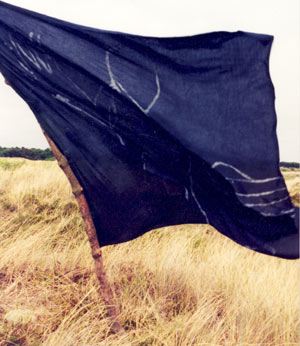
|
My "sand tattoo" consisted of nine spiral forms symbolising nine points of contact. Most of the other drawings varing from a mountain-castle of spirals to a fish-like or sun-like icons, also related to the artist's other work on the island.
Excerpts from Arts Dialogue, pages 4 - 7, December 1996.
|

Arts Dialogue, Dintel 20, NL 7333 MC, Apeldoorn, The Netherlands
email: bafa@bahai-library.com
|
|





























